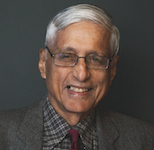As C Rajagopalachari's Grandson, My Questions On Sengol Story
Aided by a government-made video, Home Minister Amit Shah presented the 'Sengol' story to the nation at a press conference. He did this shortly before the scheduled inauguration on May 28 of the new parliament building.
According to the story, Mountbatten, the last British viceroy but also the man invited by the leaders of about-to-be-free India to stay on as Governor General, asked Jawaharlal Nehru whether there was a suitable Indian ceremony of transferring power. Nehru, the story goes, in turn sought the advice of Chakravarti Rajagopalachari (1878-1972), better known as Rajaji, who was one of Nehru's senior colleagues in the interim government (1946 to August 1947) and later, Mountbatten's successor as the country's Governor General (1948-1950). After due research, Rajaji, it is said, recommended an old practice of South India's ancient Chola kingdom of handing a jewelled sceptre, the Sengol, to a new ruler, along with advice to be just.
Accordingly, the story continues, a well-known jeweller in Chennai was asked by Rajaji to prepare a suitable sceptre, which was then flown to Delhi by a group of religious leaders from Tamil Nadu's Thanjavur area and presented, in an appropriate ceremony, to would-be-Premier Nehru at his residence, 17 York Road, at 10.45 pm on August 14, 1947. This was apparently shortly before Nehru made his famous Tryst with Destiny speech at midnight.
A report in The Hindu, however, suggests that the Sengol was first given to Mountbatten, who passed it on to Nehru.
Various reports say a senior priest handed over the sceptre to Mountbatten and then took it back. It was sprinkled with gangajal or holy Ganga water, taken in a procession to Prime Minister Nehru and handed over to him, the reports say.
When Prime Minister Modi learnt the Sengol story (said Mr. Shah), he wanted the sceptre located. After a search, it was found (Mr. Shah said) in the Nehru section of the Allahabad Museum and brought to Delhi. Now a fresh group of Tamil Nadu's Hindu leaders will present this sceptre to PM Modi, who will pass it on to Lok Sabha Speaker Om Birla for permanent installation in the new Lok Sabha chamber.
Amit Shah said Prime Minister Modi wanted this done to show the continuities in India's great and long story, as also the bonds between the country's north and south.
If I am allowed a personal comment before making a couple of broader points, let me, as Rajaji's grandson and biographer, state that before the reports of Home Minister Shah's press conference appeared in the media, I had never heard of Rajaji's purported role in the Sengol story. Since the 1947 story is new to many, and not just to me, I hope that documents that confirm the roles in the story ascribed to Mountbatten, Nehru and Rajaji are made public as soon as possible. It would be good for the government's credibility.
The video that Mr. Shah released has a scene where Nehru is draped and anointed by religious leaders as well as multiple scenes where Nehru and Rajaji discuss the question of a transfer-of-power ceremony. Not every viewer will recognize that the scenes are merely enactments by present-day actors. In fact, a great many viewers of the video today and in the future may assume that they are viewing an actual religious ceremony and actual conversations between Nehru and Rajaji.
For the video not to caution viewers that they are watching enactments and not historical recordings is a serious blemish. In this government-made video, a few still photographs from that time are interspersed with the enactments, which adds to the possibility that the enactments will be taken to be documentaries.
Let us assume that it can be established that on the night of August 14, 1947, a delegation of respected spiritual leaders called on Nehru at what then was 17 York Road in New Delhi and performed a religious ceremony there. That would not make it an official ceremony, let alone a state ceremony.
From the humblest chaprasi to the Prime Minister, the Vice President, and the President, a public servant is also an individual. As individuals and in their homes, holders of state office can practise or permit rituals of their choice. However, as government servants and in public, they are obliged by our Constitution to refrain from promoting any religion or slighting any religion.
Any ceremony in the private home of a public servant, no matter how elevated, is not a state ceremony or a national ceremony.
Finally, would giving this Sengol a permanent place inside the Lok Sabha chamber be true to the letter and the spirit of the Constitution?
